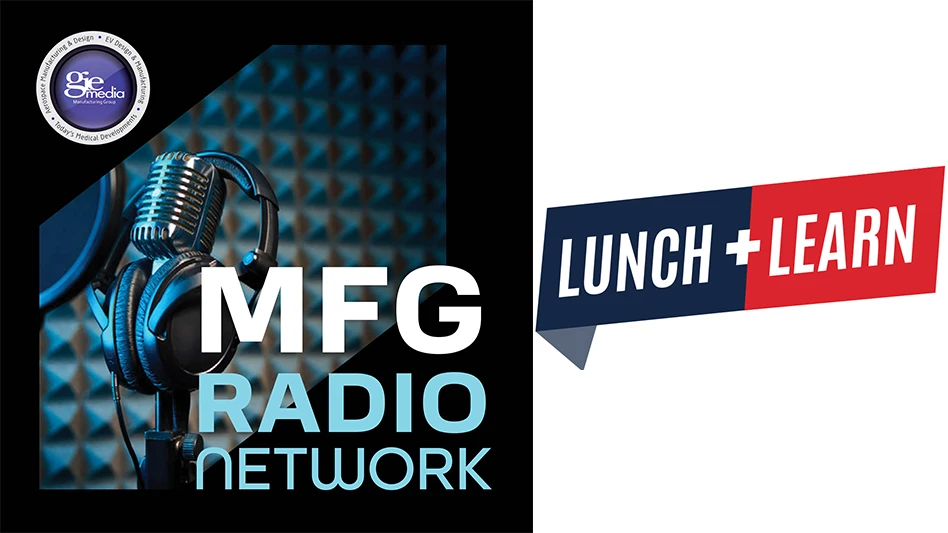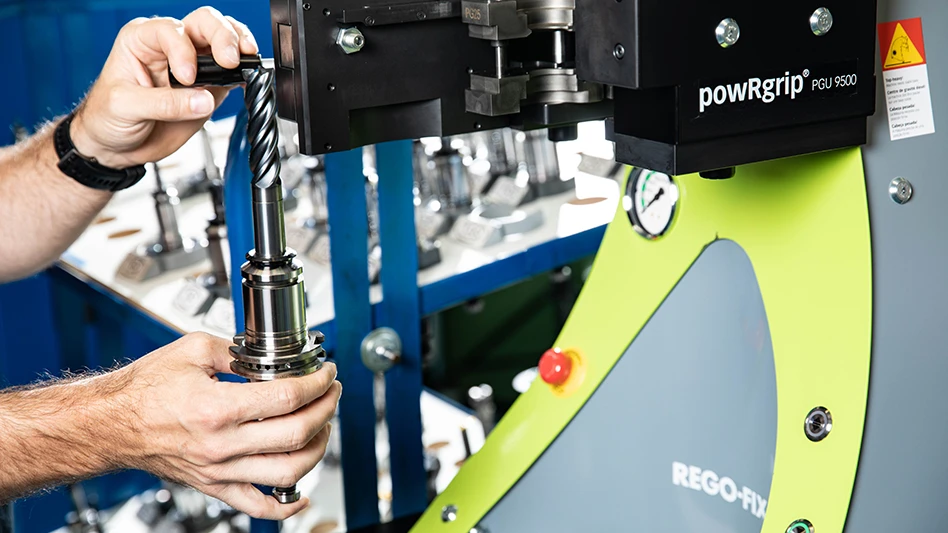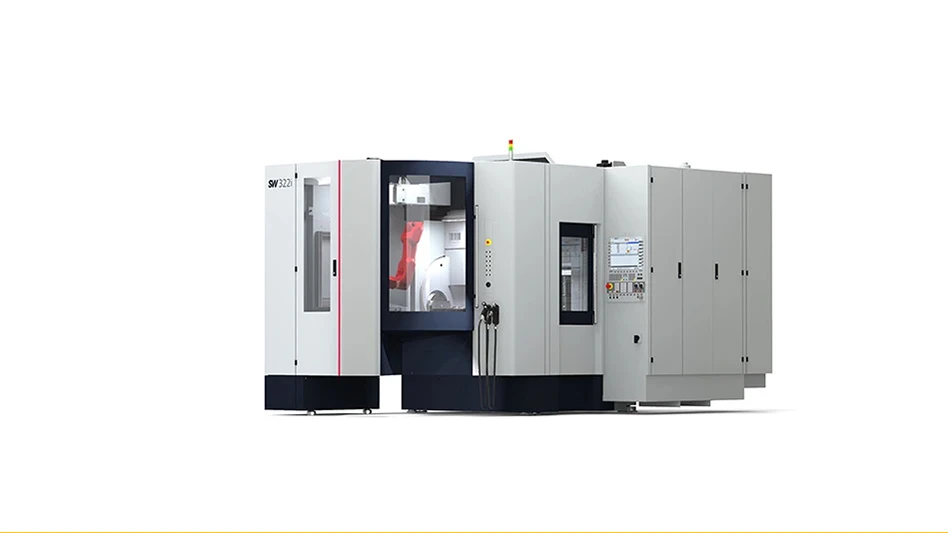 Production of this backbone implant is from solid titanium bar stock via multi-turret machining. Production of this backbone implant is from solid titanium bar stock via multi-turret machining. |
Manufacturing highly accurate, complex orthopedic components places high demands on machining technology. Challenging materials, tight tolerances, and intricate geometries combine to make orthopedic parts manufacturing a process that requires careful approach and examination in selecting the proper machine tools and cutting tools.
It all starts with the machine. Using a modern CNC machine that offers the best controls for threading, milling, or turning challenging materials is a vital consideration. Sudbury, MA-based Methods Machine Tools Inc. engineers give multi-tasking mill/turn lathes as a great example of technology that serves orthopedic manufacturers very well.
Multi-tasking mill/turn technology involves putting at least two tools in the cut to perform multiple processes on a single machine, producing a finished part. The ability to mill, drill, turn, thread, bore, or groove complex, contoured medical devices during one set-up is a great advantage to manufacturers. Successful milling and turning operations require a close examination of processes that will yield optimal productivity, profitability, and part quality.
Multi-tasking technology offers several configurations. For example, true opposing twin spindles with two turrets and milling capability allow manufacturers to reduce cycle time by as much as 50%, and give greater quality with less handling of the workpiece – producing complete parts in one machine. Adding a Y-axis to this platform significantly increases productivity by allowing shops to work on one machine to produce complex parts with features that are not on centerline.
|
End Mills Emuge offers a complete line of milling tools that are specifically designed for optimum performance in a wide range of materials and machining applications. Emuge carbide end mills are made from superior grade carbide and are manufactured under stringent technical specifications. Product features include:
|
Another configuration is a twin spindle with a B-axis tool spindle. Essentially this is a turning machine with a tool spindle like a machining center. The tool spindle offers good horsepower at 10, 15, and 20, the ability to change tools like a vertical mill, and a Y-axis capability.
This technology also adds the tool magazine to the machine, allowing for 40, 60, 80, 100, or more tools. This design of multi-tasking allows for a reduction in setup time because the tools stay resident in the tool magazine and do not need removal. For instance, complete machining of complex orthopedic parts – including intricate angle features – is possible because a B-axis tool spindle can change to any angle as easily as a new program position.
Adding lower turret technology makes it possible to reduce cycle and setup times when manufacturing small lots of complex parts. Today, multi-tasking technology enables the effective manufacturing of many intricate medical components.
Turning Up Efficiency
Machine tools builders are now offering turning systems with a twin spindle (20hp to 30hp), and three turrets with all turrets Y-Axis capable. The three turrets provide 36 to 72 tool stations – capable of 10hp milling at 40Nm torque on all stations. For example, Methods offers Nakamura-Tome Multi-tasking Turning Centers including the NT-Series with two or three turrets, and high power milling, combined with a Y-axis.
This current technology allows production of a family of orthopedic parts with complex features. By using three tools simultaneously in the cut, manufacturers realize dramatic cycle time reductions. In addition, since the bar stock actually becomes the fixture, no additional fixtures are necessary to produce complex shapes with tight geometric tolerances. For example, an orthopedic manufacturer producing a backbone implant from solid titanium bar stock benefits from multi-turret machining.
This manufacturer produces a family of backbone implants, ranging in sizes from 0.65" to 1.30". There are some similar features including serration, but the holes, milled window and different angle surfaces require different tool sizes.
With a multi-turret machine, no tools require changing when manufacturing the various size parts. In this backbone implant example, all of the tools are ready on the machine for the whole family of implants. This allows the operator to merely change the machine program, and run a different size part from the family. The other advantage with this method is the elimination of first-piece article for inspection each time an additional part runs, because there is no new set-up. The program and tools are all still qualified from the original first piece inspection.
Both short and long production runs occur with great efficiency because no setup time is required. The three turrets with multiple tools resident means no tool changes are needed – the operators can change the bar size or workholding, call up a new program and start making the part.
There are many advantages to multi-tasking today, however the primary advantage is less process time or cycle time to produce a complete part. Even with complex parts, a mill/turn lathe offers many advantages. Today with all the different machine configurations – two turrets, three turrets, three turrets with Y-axis or a B-axis tool-changing machine, the possibilities are endless.
This does not mean that a horizontal machine or a 5-axis milling machine is replaceable with a mill/turn lathe. However, when it comes to productivity and profitability, multi-tasking is hard to beat. It is highly desirable for any part with turning, drilling, or boring, OD or ID threads, and a few mill features, such as a square or hex, or even a bolt hole pattern.
To maximize profits even further, manufacturers can reach lights out, unattended operation making manufacturing costs lower and profits higher using simple automation such as magazine barfeeders, multi-pallet machines, and robotics. Machine tool manufacturers are also supplying software features like tool load monitoring and tool life management to make lights out or unattended running highly successful.
 Top: As the demand in today’s market increases for smaller parts with more efficient machining solutions, so do the threading solutions from Emuge. Photo courtesy of Emuge Corp. Bottom: Emuge engineers are able to offer solid carbide end mills featuring select sub-micro grain carbide construction and advanced cutting geometries for among others, demanding orthopedic applications. Photo courtesy of Emuge Corp. Top: As the demand in today’s market increases for smaller parts with more efficient machining solutions, so do the threading solutions from Emuge. Photo courtesy of Emuge Corp. Bottom: Emuge engineers are able to offer solid carbide end mills featuring select sub-micro grain carbide construction and advanced cutting geometries for among others, demanding orthopedic applications. Photo courtesy of Emuge Corp. |
Making the Cut
Cutting tools are the other key to an orthopedic manufacturer’s success. For example, by using the most optimal end mills, a manufacturer can succeed on several fronts: high quality surface finishes, long tool life, and the ability to meet demanding stock removal requirements and delivery times.
Emuge Corp., West Boylston, MA, offers solid carbide end mills featuring select sub-micro grain carbide construction and advanced cutting geometries for among others, demanding orthopedic applications. Tool designs vary depending on the material to be machined, such as titanium, stainless steels, and other exotic alloys. In addition, specially engineered coatings provide maximum cutting performance and tool life. Offering unmatched reliability, the cutting tools consistently produce exceptional material removal rates and surface finish quality, and come in a variety of styles and sizes.
Employees at Micron Integrated Technologies, Fitchburg, MA, a wholly owned subsidiary of Arrhythmia Research Technology, are using Emuge end mills to automate the company’s production of orthopedic devices/implants. Micron uses an Emuge 1/2" torus tool to rough out cobalt chrome parts. Besides doubling tool life, the Emuge end mills substantially minimize chatter and provide a much better finish in heavy cutting. Additionally, feedrates have doubled, and in some cases tripled. Because of the dramatic increase in tool life and productivity since switching to Emuge tools, Micron has saved considerably on their tooling costs.
Micron found that the Emuge tools are more resistant to wear and have eliminated the breakage problems that thwarted their automation efforts. For example, with the best performing 3/16" ballnose end mill Micron was previously using, the chipload was 0.0005" and spindle speed was 5,000rpm running at 10ipm. The Emuge 3/16" ballnose tool runs at 4,700rpm, with a chip load of almost 0.002" and the feedrate of 35ipm.
“Surface finish quality has improved considerably as well. We eliminated 10-15 minutes per part in our secondary polishing operations,” comments Dan Doiron, lead programmer and machinist at Micron.
 Nakamura-Tome NTY3-250 multi-tasking turning center from Methods Machine Tools Inc. Nakamura-Tome NTY3-250 multi-tasking turning center from Methods Machine Tools Inc. |
Tapping Out Success
When an orthopedic component requires internal threading, Emuge engineers offer several tips below for using taps to thread challenging materials. Best performance results will be realized with good taps, and the use of modern tap holders and related equipment, combined with a positive speed and feed control of the machine.
- Tapping speed is critical for cutting threads in hard materials and will result in tap failure and/or shortened tap life if not followed
- In materials with a hardness of 30Rc or greater, Emuge recommends a tapping speed of 10sfm to 13sfm for entering and exiting out of the tapped hole
- Consider quality emulsions that include a higher percentage of oil and tapping oil; tapping fluid (coolant lubricant) will affect tap life; for exceedingly difficult-to-cut alloys, consider using a tapping paste for extreme pressure applications
- Emuge recommends using taps designed specifically for tough materials and alloys; for example, Emuge has two designs of taps for cutting threads in titanium alloys:
- For through-hole applications, use the Emuge Rekord C-Ti series tap – this tap has an 8° to 10° left-hand spiral flute, designed for right-hand cutting in through holes, and is combined with a 4-5 thread chamfer, in addition to face rake and relief characteristics designed for cutting the tough alloy material
- For blind-hole applications, use the Emuge Rekord D-Ti series tap – this tap has a 10° to 15° right-hand spiral flute, designed for right hand threads, it is combined with a 2-3 thread chamfer, in addition to face rake and relief characteristics designed for cutting the tough alloy material
- For best results, high performance tap holders should be used to provide a rigid set-up; Emuge recommends rigid/synchronous tapping cycles with Soft-synchro collet-type tap holders; when using CNC machines without a rigid tap cycle, a quality tap holder with an initial hard start feature and proper feed control programming will yield the best results; for manual tapping machines, Emuge recommends using quality tap holders with the initial hard start features
- For the highest accuracy and repeatability, examine your workholding system to ensure it can adequately hold the part; rigid set-ups that minimize vibrations are especially important, because orthopedic parts consist of exotic materials with complex shapes
- For through-hole applications, use the Emuge Rekord C-Ti series tap – this tap has an 8° to 10° left-hand spiral flute, designed for right-hand cutting in through holes, and is combined with a 4-5 thread chamfer, in addition to face rake and relief characteristics designed for cutting the tough alloy material
 Shown above are femoral components for use in a knee implant. Photos courtesy of Micron Integrated Technologies Shown above are femoral components for use in a knee implant. Photos courtesy of Micron Integrated Technologies |
Thread Mills Solution
Emuge engineers also recommend thread mills for orthopedic threading applications. Design of these tools is for high cutting speeds and feeds, producing threads with excellent form, finish, and dimensional accuracy. Optimum precision and accuracy are achieved by exact thread depth and position control. Other thread milling advantages include, but are not limited to, easy machining of difficult materials, elimination of the possibilities and consequences of tap breakage, and the production of small, controllable chips. When orthopedic manufacturers combine thread milling with the latest CNC technology and smart controllers, they can realize outstanding flexibility, process control, tool life, and part quality.
Conclusion
With so many machine tools and cutting tools on the market, it is imperative to consult with your suppliers’ application engineers to choose the best solution for your orthopedic machining application. Doing so will improve productivity and quality, while reducing cost in your operation. It pays to analyze, carefully, the application at hand before making any chips.
|
The part includes many special threaded holes to accept the various bone screw head shapes and a special angle locking form in the hole and radius features on the sides. A special round boss on the two ends and burrs present challenges due to various angles intersections. This description sounds like a typical vertical or horizontal machining application. However, it could be manufactured on a multitasking turning center. For comparison purposes, here are the two machining processes hypothetically illustrated:
|
Emuge Corp.
West Boylston, MA
emuge.com
Methods Machine Tools Inc.
Sudbury, MA
methodsmachine.com

Explore the May 2012 Issue
Check out more from this issue and find your next story to read.
Latest from Today's Medical Developments
- Tariffs threaten small business growth, increase costs across industries
- Feed your brain on your lunch break at our upcoming Lunch + Learn!
- Robotics action plan for Europe
- Maximize your First Article Inspection efficiency and accuracy
- UPM Additive rebrands to UPM Advanced
- Master Bond’s LED415DC90Med dual-curable adhesive
- Minalex celebrates 60 years of excellence in miniature aluminum extrusions
- Tormach’s Chip Conveyor Kit for the 1500MX CNC Mill
 The Challenge:
The Challenge: 





